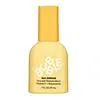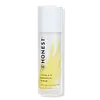What's inside
What's inside
 Key Ingredients
Key Ingredients

 Benefits
Benefits

 Concerns
Concerns

 Ingredients Side-by-side
Ingredients Side-by-side

Water
Skin ConditioningSodium Ascorbyl Phosphate
AntioxidantCoco-Caprylate/Caprate
EmollientGlycerin
HumectantNiacinamide
SmoothingAlpha-Arbutin
AntioxidantTranexamic Acid
AstringentCeramide NP
Skin ConditioningCeramide AP
Skin ConditioningCeramide As
Skin ConditioningCholesterol
EmollientCeramide Ns
Skin ConditioningCeramide EOP
Skin ConditioningXanthan Gum
EmulsifyingBrassica Campestris Seed Oil
Skin ConditioningEthylhexylglycerin
Skin ConditioningGlycyrrhiza Glabra Root Extract
BleachingPolyglyceryl-3 Diisostearate
EmulsifyingSorbitan Isostearate
EmulsifyingHydrogenated Lecithin
EmulsifyingAlthaea Officinalis Root Extract
Skin ConditioningOryza Sativa Bran Extract
Skin ConditioningDipropylene Glycol
HumectantGlyceryl Stearate
EmollientHydroxyethyl Acrylate/Sodium Acryloyldimethyl Taurate Copolymer
Emulsion StabilisingSodium Polyacryloyldimethyl Taurate
Emulsion StabilisingSodium Polyacrylate
AbsorbentSucrose Distearate
EmollientPhenoxyethanol
PreservativeWater, Sodium Ascorbyl Phosphate, Coco-Caprylate/Caprate, Glycerin, Niacinamide, Alpha-Arbutin, Tranexamic Acid, Ceramide NP, Ceramide AP, Ceramide As, Cholesterol, Ceramide Ns, Ceramide EOP, Xanthan Gum, Brassica Campestris Seed Oil, Ethylhexylglycerin, Glycyrrhiza Glabra Root Extract, Polyglyceryl-3 Diisostearate, Sorbitan Isostearate, Hydrogenated Lecithin, Althaea Officinalis Root Extract, Oryza Sativa Bran Extract, Dipropylene Glycol, Glyceryl Stearate, Hydroxyethyl Acrylate/Sodium Acryloyldimethyl Taurate Copolymer, Sodium Polyacryloyldimethyl Taurate, Sodium Polyacrylate, Sucrose Distearate, Phenoxyethanol
Water
Skin ConditioningGlycerin
HumectantPropanediol
SolventPyrus Malus Fruit Extract
Skin ConditioningCynara Scolymus Leaf Extract
Skin ConditioningAloe Barbadensis Leaf Juice Powder
Skin ConditioningDiglucosyl Gallic Acid
Citric Acid
BufferingLysolecithin
EmulsifyingSclerotium Gum
Emulsion StabilisingXanthan Gum
EmulsifyingPullulan
Silica
AbrasiveSodium Acetylated Hyaluronate
HumectantSodium PCA
HumectantErythritol
HumectantCarrageenan
Hydrolyzed Sodium Hyaluronate
Skin ConditioningIsopentyldiol
HumectantTrifolium Pratense Flower Extract
AstringentCananga Odorata Flower Water
Skin ConditioningTrisodium Ethylenediamine Disuccinate
1,2-Hexanediol
Skin ConditioningCaprylhydroxamic Acid
Sodium Ascorbyl Phosphate
AntioxidantTin Oxide
AbrasiveBenzoic Acid
MaskingSorbic Acid
PreservativeSodium Hydroxide
BufferingPotassium Sorbate
PreservativeSodium Benzoate
MaskingCI 77891
Cosmetic ColorantMica
Cosmetic ColorantWater, Glycerin, Propanediol, Pyrus Malus Fruit Extract, Cynara Scolymus Leaf Extract, Aloe Barbadensis Leaf Juice Powder, Diglucosyl Gallic Acid, Citric Acid, Lysolecithin, Sclerotium Gum, Xanthan Gum, Pullulan, Silica, Sodium Acetylated Hyaluronate, Sodium PCA, Erythritol, Carrageenan, Hydrolyzed Sodium Hyaluronate, Isopentyldiol, Trifolium Pratense Flower Extract, Cananga Odorata Flower Water, Trisodium Ethylenediamine Disuccinate, 1,2-Hexanediol, Caprylhydroxamic Acid, Sodium Ascorbyl Phosphate, Tin Oxide, Benzoic Acid, Sorbic Acid, Sodium Hydroxide, Potassium Sorbate, Sodium Benzoate, CI 77891, Mica
 Reviews
Reviews

Ingredients Explained
These ingredients are found in both products.
Ingredients higher up in an ingredient list are typically present in a larger amount.
Glycerin is already naturally found in your skin. It helps moisturize and protect your skin.
A study from 2016 found glycerin to be more effective as a humectant than AHAs and hyaluronic acid.
As a humectant, it helps the skin stay hydrated by pulling moisture to your skin. The low molecular weight of glycerin allows it to pull moisture into the deeper layers of your skin.
Hydrated skin improves your skin barrier; Your skin barrier helps protect against irritants and bacteria.
Glycerin has also been found to have antimicrobial and antiviral properties. Due to these properties, glycerin is often used in wound and burn treatments.
In cosmetics, glycerin is usually derived from plants such as soybean or palm. However, it can also be sourced from animals, such as tallow or animal fat.
This ingredient is organic, colorless, odorless, and non-toxic.
Glycerin is the name for this ingredient in American English. British English uses Glycerol/Glycerine.
Learn more about GlycerinSodium Ascorbyl Phosphate is a form of Vitamin C. It is the salt of ascorbic acid.
This ingredient is more gentle than ascorbic acid. It is also more stable when exposed to light and oxygen.
Vitamin C helps reduce redness, improve skin texture, reduce the effects of aging, reduce the visibility of dark spots, and brighten skin.
Your skin uses Vitamin C to produce collagen and collagen production plays a role in having a strong skin barrier and plump skin. As an antioxidant, this ingredient also helps reduce the signs of aging such as fine-lines and wrinkles.
VItamin C helps brighten skin by blocking the process of skin darkening.
In a 2011 study, Sodium Ascorbyl Phosphate was found to have antibacterial properties. This may help treat acne.
Read more about other types of Vitamin C:
Learn more about Sodium Ascorbyl PhosphateWater. It's the most common cosmetic ingredient of all. You'll usually see it at the top of ingredient lists, meaning that it makes up the largest part of the product.
So why is it so popular? Water most often acts as a solvent - this means that it helps dissolve other ingredients into the formulation.
You'll also recognize water as that liquid we all need to stay alive. If you see this, drink a glass of water. Stay hydrated!
Learn more about WaterXanthan gum is used as a stabilizer and thickener within cosmetic products. It helps give products a sticky, thick feeling - preventing them from being too runny.
On the technical side of things, xanthan gum is a polysaccharide - a combination consisting of multiple sugar molecules bonded together.
Xanthan gum is a pretty common and great ingredient. It is a natural, non-toxic, non-irritating ingredient that is also commonly used in food products.
Learn more about Xanthan Gum